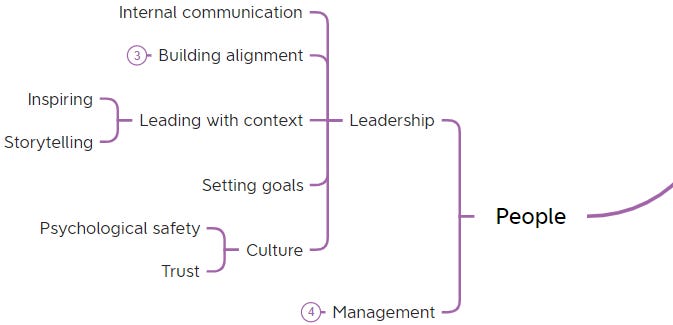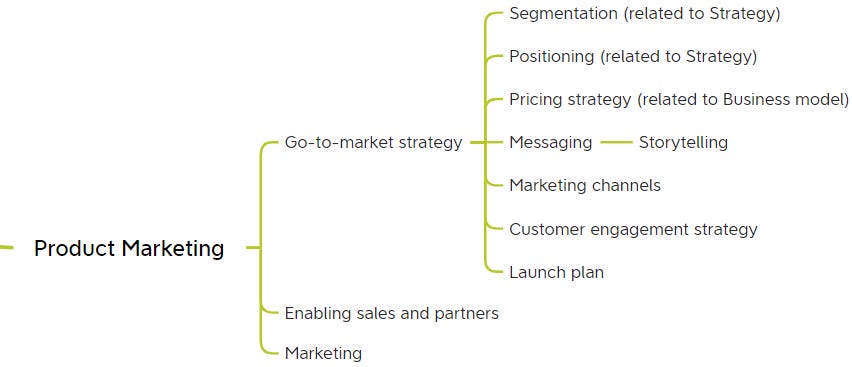Product Manager Competencies Map + Skills Assessment
Hey, Paweł here. Welcome to the free edition of The Product Compass!
Today’s topic was selected on Slack by our premium members.
🎯 Starting now, skill assessments will be a regular feature in this newsletter. My goal for the next 12 months is to increase your market value by 30% as a PM.
You can regularly:
Test your knowledge,
Identify areas for improvement,
Get recommended learning materials.
Premium subscribers can also reach out to me on Slack. Feel free to discuss doubts, ask questions, and get personalized advice. I'll even review your resume.
If you haven't upgraded your account yet, now's the time for the full experience:
Product Manager Competencies Map + Skills Assessment
In today’s newsletter:
Product Management Skills
Product Management Skills Required by Role
Product Management Skills Assessment
Product Manager Competencies Map
The Next Steps
Let's dive in!
1. Product Management Skills
I’ve broken down Product Management into eight categories:
Next, I’ll dive into what you need to know and share recommended resources.
1.1 Business and Strategy
The key product management skills:
Strategy is a set of choices that help you win in your chosen market. It defines the vision, market, value proposition, tradeoffs, and growth model, among others. It should be hard for competitors to copy.
You should understand:
What strategy is, and what it's not.
Models like SWOT, PESTLE, and Porter's Five Forces.
Market size metrics like TAM, SAM, and SOM.
How to make a business model to outline how your company will make money. This is often done with Business Model Canvas or Lean Model Canvas.
Resources:
Product Vision, Strategy, Goals, and Roadmap: The Advanced Edition
How to Achieve Product-Market Fit? Part I: Market and Value Proposition
1.2 Execution
The key product management skills:
Execution is the stage where strategy turns into action.
You should understand:
Objectives and Key Results (OKRs) for setting goals and measuring outcomes.
Techniques for prioritizing, making decisions, and managing risks.
Approaches like Agile, Lean, and DevOps.
Resources:
1.3 People
The key product management skills:
Leadership involves inspiring, influencing, and guiding others without authority.
As a leader, you should understand how to:
Inspire with the vision.
Lead with strategic context so that team members understand why the work is important and how it aligns with the strategy. It allows them to make better autonomous decisions.
Build a culture based on trust and psychological safety.
Get buy-in and resolve conflicts.
Resources:
1.4 Data Analytics
The key product management skills:
Data analytics is the backbone of data-driven product management.
You should know:
Frameworks like the North Star Framework and One Metric That Matters so that you can focus on just a few key metrics.
Other techniques like customer segmentation, funnel analysis, heatmaps, and session recordings to get additional insights into user behavior.
How to read the data and extract the essential insights.
Data analytics is a concept broader than product analytics and includes analyzing data from other sources (e.g., CRM, transactional data).
Resources:
1.5 Product Discovery
The key product management skills:
Product Discovery is the most critical area for a Product Manager.
You should know how to:
Explore the Problem Space to understand and define opportunities (problems, needs, desires),
Explore the Solution Space to brainstorm possible solutions, formulate testable assumptions, and plan experiments to prove or disprove those assumptions.
Identify high-risk assumptions about value, usability, feasibility, viability, and ethics to tackle them before implementation.
Work with both new and existing products.
Resources:
1.6 Experimentation
The key product management skills:
Experimentation is crucial for validating assumptions.
You should know:
Different kinds of MVP Prototypes (or “Pretotypes”) help you validate product ideas at an early stage, in particular, market engagement hypotheses.
User prototypes and how to use them in experiments like first-click testing, card sorting, 5-second tests, and more to assess the value and usability of specific features.
Other methods like A/B testing and multivariate resting to get statistical data on how changes affect your metrics.
Resources:
1.7 Product Marketing
The key product management skills:
The role of a Product Marketer (or Product Marketing Manager, PMM for short) varies across companies. However, the best product companies:
“While the product manager focuses on the product side of the equation, the product marketer focuses o the market side, including the go-to-market strategy” - Martina Lauchengco, Loved
You should understand:
How to communicate your product's value.
How to prepare and execute a go-to-market.
How to enable sales and partners to spread the word.
Resources:
1.8 Product Growth
The key product management skills:
Product Growth focuses on scaling the product and gaining wider adoption.
You should know:
How product-led growth combines sales, marketing, onboarding, and support, all led by the product.
Terms like Time to Value (TTV) and the "Aha moment."
How to enhance onboarding using the Bowling Alley Framework.
Different pricing models, their differences, advantages, and disadvantages.
Resources:
2. Product Management Skills Required by Role
My assessment of the required competencies comes from interviewing over 200 product professionals via video calls in the past year, plus my 10+ years of experience in product.
Keep in mind that results can vary a lot depending on the organization.
3. Product Management Skills Assessment
Below, you'll find a link to a graded skills assessment with 32 questions from each of those product management areas:
Strategy and Business (4 points)
Execution (4 points)
People (4 points)
Data Analytics (4 points)
Product Discovery (4 points)
Experimentation (4 points)
Product Marketing (4 points)
Product Growth (4 points)
Take the test, check your knowledge, get feedback, and keep on learning: https://forms.gle/NimGpmWRWEDKbaHi8
[Edit 1/14/2024] A score distribution after getting 1,428 responses:
4. Product Manager Competencies Map
An interactive document: https://xmind.works/share/PnDamsJH
Please note that this is a living document. I'll be adding more information, resources, and clickable links soon.
5. The Next Steps
🎯 Starting now, skill assessments will be a regular feature in this newsletter. My goal for the next 12 months is to increase your market value by 30% as a PM.
At least once a month, you can:
Test your knowledge,
Identify areas for improvement,
Get recommended learning materials.
Premium subscribers can also reach out to me on Slack. Feel free to discuss doubts, ask questions, and get personalized advice. I'll even review your resume.
Upgrade your account, if you haven’t already, to get a full experience:
If you have any ideas on what I can improve, I’m happy to listen: pawel@productcompass.pm
Thanks for reading The Product Compass
It’s incredible to learn and grow together 👊😊
Have a fabulous weekend and a fantastic week ahead,
Paweł















It is the first time I see all these areas in product linked together in a logical manner. Thank you for sharing, and the hard work involved to establish such a clear picture.
It appears you missed the financial part. I mean unit economics, P&L, cash-flow, financial modelling, BEP.